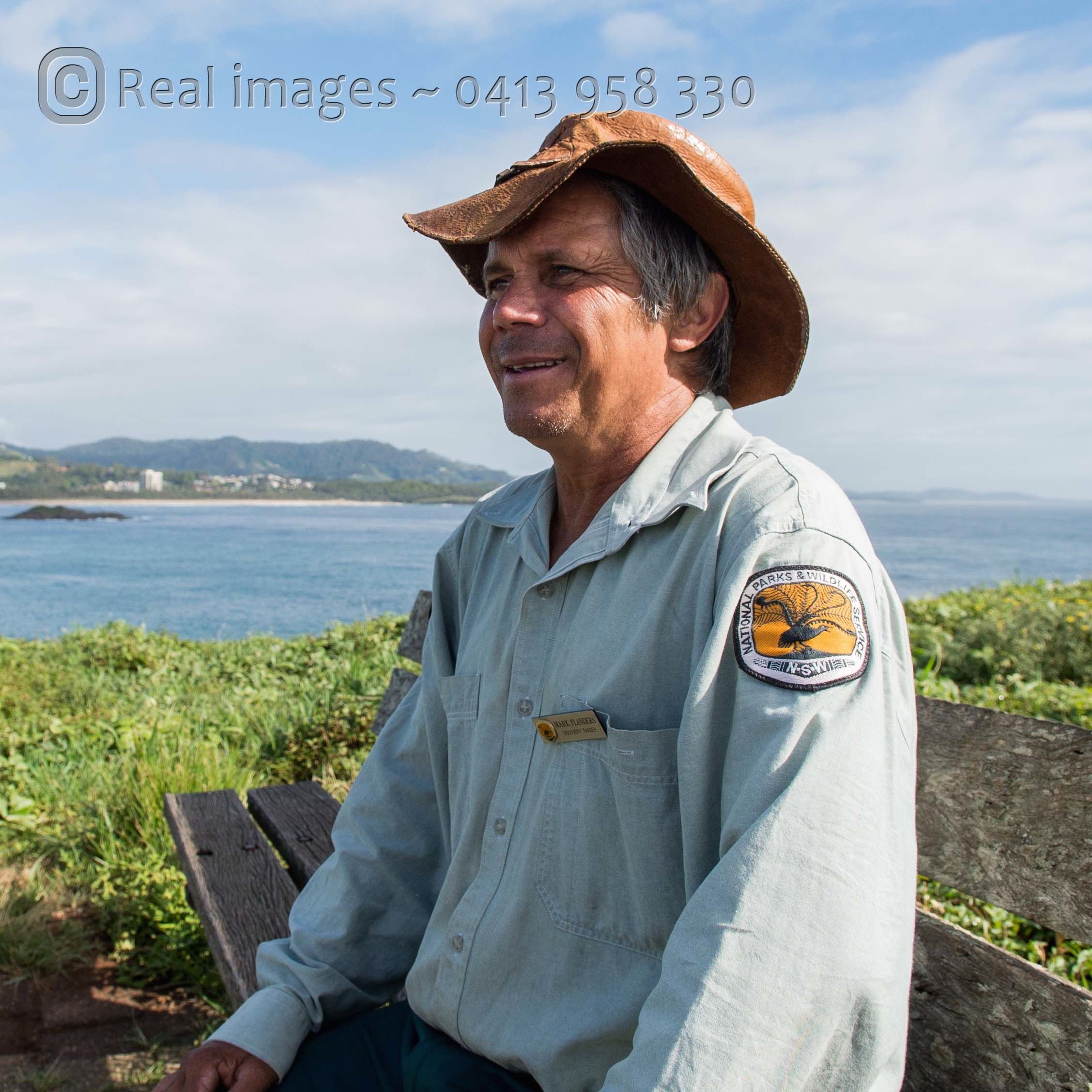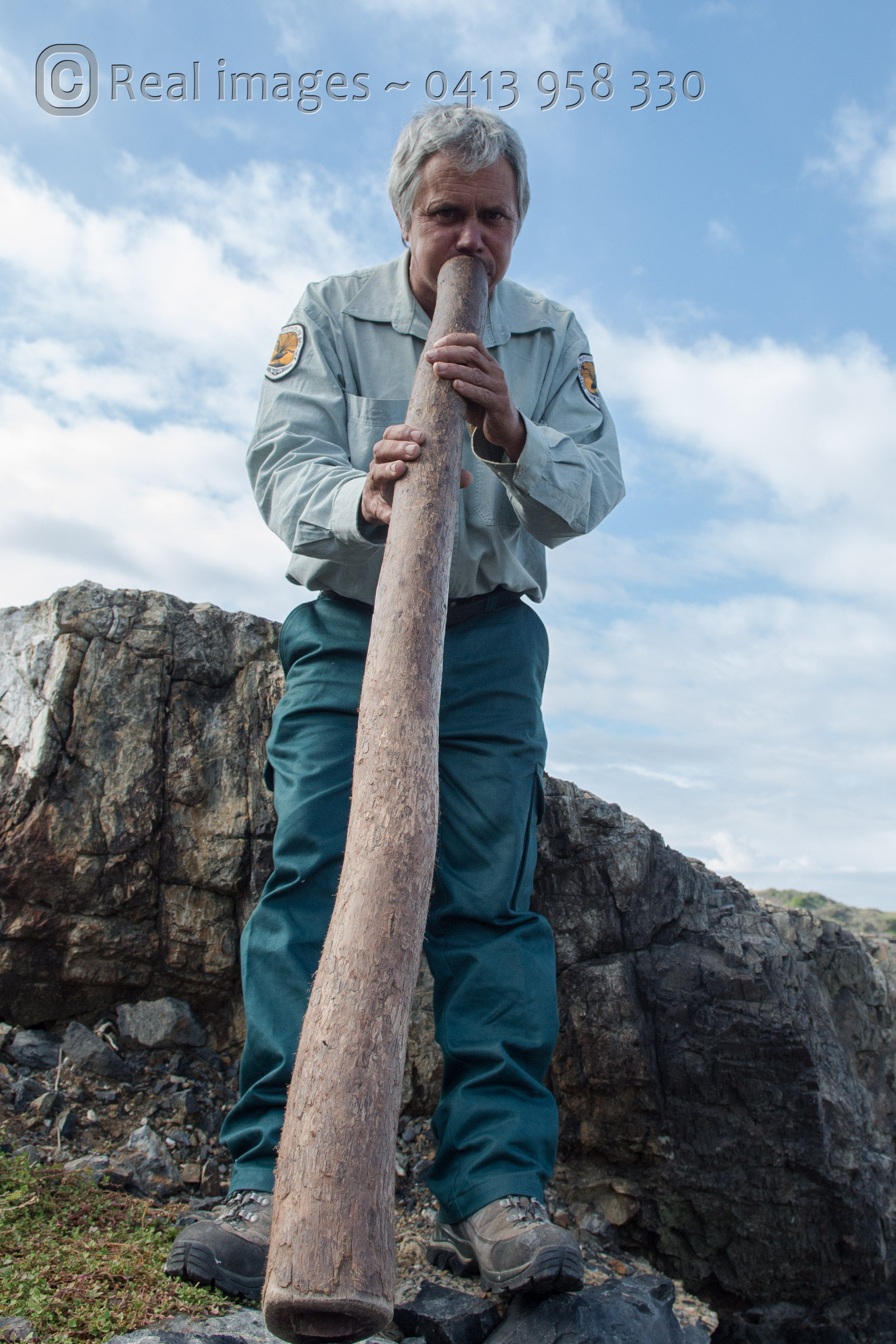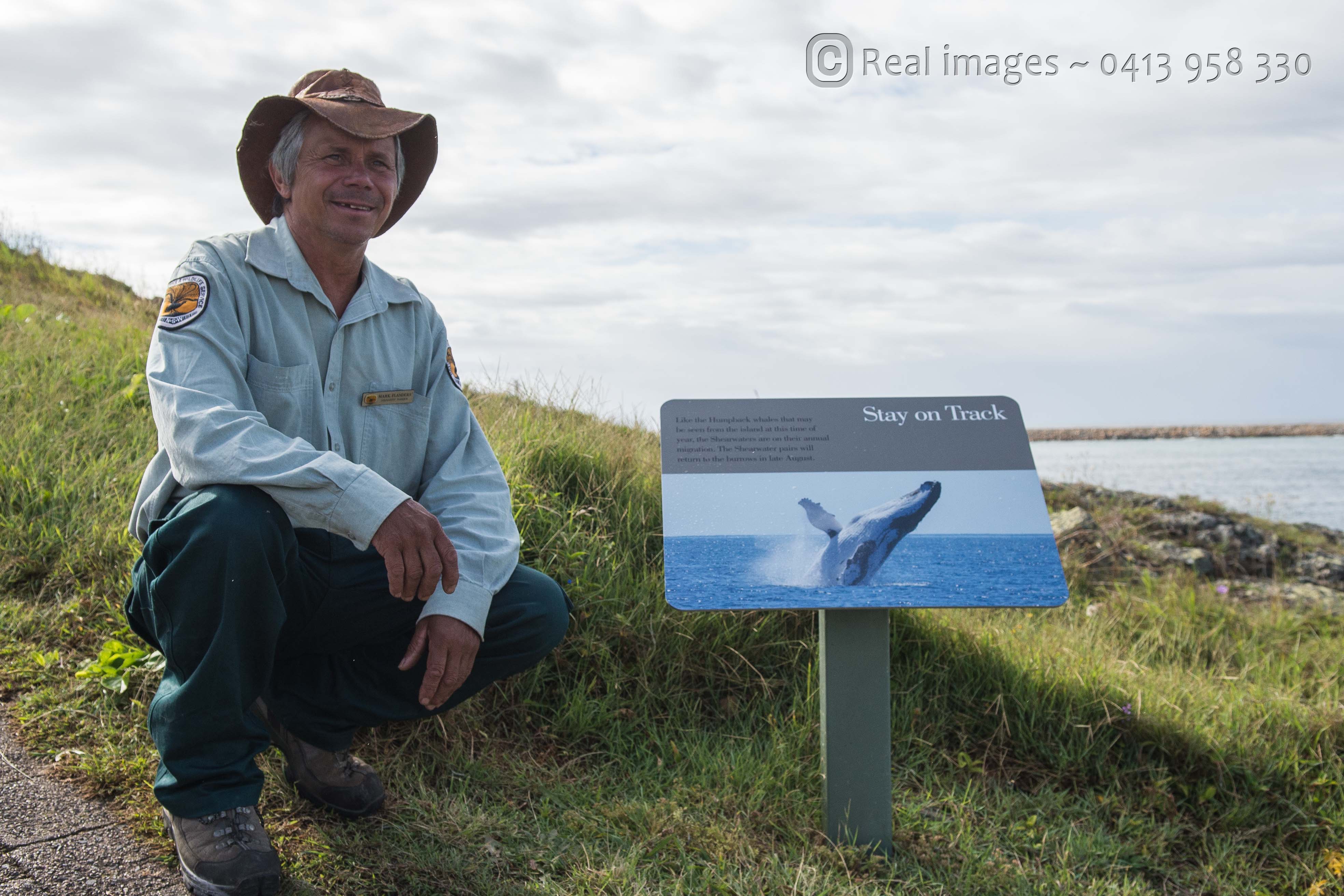 Stephanie Hunt |
Stephanie Hunt |  Thu, April 10, 2014 at 12:00 |
Thu, April 10, 2014 at 12:00 | Sandy van Veluwen tells me that Mark Flanders is the most interesting person she knows. Mark is an Aboriginal Discovery Ranger and Sally sometimes leads National Parks canoe trips with him. "He's an incredibly passionate, loving person," she says. "He's a tiny little man but he's just a dynamo. A great role model and teacher." I decide to join one of Mark's tours.
******************************************************
 Guardian of Knowledge
Guardian of Knowledge
The skies loom dark and threatening as we stand on the bluffs overlooking Moonee Beach on NSW’s mid north coast. My husband and I have braved the weather forecasters' dismal predications, along with 16 other locals, all white, mostly middle aged, to find out more about the landscapes and history of our own backyard.
Mark Flanders, Aboriginal Discovery Ranger with National Parks, will be our guide along a section of the 60km Solitary Islands Walk. He starts here on the Moonee Bluffs by explaining that this is a special place. “That’s obvious,” I think to myself, admiring the splendor of the wind swept dunes and the empty, white sand beach below, stretching to the dark, simmering sea.
But Mark is not referring to the beauty of this place; it is the history that interests him. His weathered hand points toward the dune ahead of us. “Look straight ahead, just over there is a huge midden* complex,” he says. The yellow sand and burnt orange rocks I had mistaken for another dune, is in fact a garbage dump of shells, bones, discarded tools and the buried dead of an ancient people…Mark’s people.
This “garbage dump” is precious because so little remains of the ancient Gumbaynggir people who once roamed the beaches and hills between the Nambucca and Clarence Rivers and from Point Lookout over the Great Dividing Range to the Pacific Ocean.
 “When Captain Cook come through he was amazed that every headland had a fire burning on it,” Mark explains. “But when the early white settlers did finally arrive in the 1880s, they didn’t see many Aboriginal people. Diseases had already gone through our populations.”
“When Captain Cook come through he was amazed that every headland had a fire burning on it,” Mark explains. “But when the early white settlers did finally arrive in the 1880s, they didn’t see many Aboriginal people. Diseases had already gone through our populations.”
The subsequent loss of Gumbaynggir culture is a tragedy, but it has given Mark Flanders his purpose in life. The majority of Mark’s adult life has been spent learning about this lost culture and working tirelessly to ensure that his learning and knowledge is passed on to future generations. “That’s what the Aboriginal culture is about: teaching,” he tells me.
And Mark is a dream teacher. A small man with a quick grin and a merry sparkle in his eye, his enthusiasm is infectious. The son of a Gumbaynggir man and white woman, he has lived on Gumbaynggir lands in Coffs Harbour for nearly all of his 50 years. And he loves it.
He recalls a childhood spent with his brother, two sisters and a wealth of cousins playing in a backyard replete with bush land, creeks and ocean. He played with black and white children alike, never sensing discrimination.
“It was around, but you didn’t recognise discrimination until you got older. I remember a mate was going to come round to play. He was a white kid, and he said, ‘Mum and Dad want to know is there broken glass around everywhere.’ I didn’t know what he was talking about – and I wouldn’t work it out until much later in life.”
Mark laughs at the retelling of this old prejudice, clearly less offended than amused by the obvious ignorance. But Mark was less amused by what he viewed as reverse discrimination at Orara High School. “You can’t do Aboriginal studies because you’d disadvantage the rest of the white kids in the school,” Mark remembers being told. He claims this denial first set his determination to learn more about Aboriginal culture.
But in 1980s Coffs Harbour there was no money to be made from Aboriginal culture. Mark turned to the timber industry after school. His grandfather owned a sawmill. His father worked in the sawmill. Mark himself had been helping out in his grandfather’s sawmill since he was 8. The career choice was obvious.
Mark married a white woman and had 3 children, Daniel, Joel and Matthew. “All taller than me,” he says with glee, “Better (milk) formula in them days.” In time, he moved up from the rough timbers in the sawmill to turning fine, clean timbers at Coramba Timbers.
Then, in his mid-30s, Mark grew restless. His marriage ended and he grew tired of the timber industry. “I decided I was going to start working with my peple,” he says. I wonder out loud why the child of a white woman and a black man would choose to identify his Aboriginal heritage as “my people”. Mark is quick to reply. “Well I could see where our mainstream is going – the destruction of country. There’s so much to be learned (from) Aboriginal culture. The more I find out, the blacker I get.”
 And wandering along the Solitary Islands Walk toward Emerald Beach, there is little doubt that Mark is a proud, learned Gumbaynggir man. We pass some tall dry grasses and Mark stops. “This here is called Nobby’s Rush. You can eat these little sections,” he says, pointing to the dry seedpods at the top of the grass. “They are like eating a dried Vita-Brit – but it will sustain you. Here, have a chew.” Just like a Vita-Brit I find it hard to swallow without milk.
And wandering along the Solitary Islands Walk toward Emerald Beach, there is little doubt that Mark is a proud, learned Gumbaynggir man. We pass some tall dry grasses and Mark stops. “This here is called Nobby’s Rush. You can eat these little sections,” he says, pointing to the dry seedpods at the top of the grass. “They are like eating a dried Vita-Brit – but it will sustain you. Here, have a chew.” Just like a Vita-Brit I find it hard to swallow without milk.
We approach the familiar fanned leaves of a pandanus tree. Mark explains that his people use the nuts to make johnny cakes and the leaves to make baskets. “But the old people say when you pick the leaves you make it rain.” He grins. I look toward those threatening skies and am relieved when he walks on without picking any leaves.
He bends to pick up a rock from just beyond the path. “This is an artifact – a cutting tool. I know because it has a concave and convex breakage.” Mark’s ability to tell that a simple rock is a relic of past Gumbaynggir life has been honed by over 15 years working with the Coffs Harbour and District Local Aboriginal Land Council (CHDLALC). As a Senior Cultural and Heritage Officer, it is his job to assess sites prior to development, ensuring that Aboriginal sacred sites and cultural artifacts are preserved.
“I have been looking after my country, touring, assessing. I’m getting a very good picture of what my people were doing a couple hundred years ago. Where our walking tracks were – our camping sites – our ceremony grounds.” And that’s not the only way that Mark is learning about his heritage. He researches, reads and he talks to people. “Every day you’re learning something new and you just keep putting it in your head.”
In Aboriginal culture, it’s as important to share knowledge as it is to learn. And that is particularly true now that Mark is an Elder. As a mark of respect for his knowledge, Mark has been treated as a young Elder since he was in his early 40s. Now he is Chair of the Garlarmbirla Guuyu Giiwarr (Coffs Harbour Elders Group) and feels the weight of his responsibility for passing on accurate knowledge to future generations – black and white
Sharing knowledge is as much a joy as a responsibility. “Every now and then I go somewhere and I’ve got this young fella, taller than me, going, ‘Uncle Mark! Remember me?’ They’ve remembered me from way back when they were in preschool. You gotta start with the youth! They’re sponges and they pass it on.”
The path suddenly narrows, crowded by a thicket of trees. Mark holds out a branch with that recognizable bristly red banksia flower. “These were once called candlesticks,” he says. “They were used to carry fire from camp to camp. Our people would take the burning embers and blow on them to set the next fire alight.”
Mark is working to pass on his own flame. “My workload is getting busier and busier all the time. I’m just at the stage now where I’m trying to create more Aboriginal employment doing what I’m doing. I can see young role models out there that will work in the future at what I’m doing.”
 And he says he’s ready to hand over some of his responsibility. “I want to go back to my shed and play wood work. I want to go fishing. I want to go camping again.” And then of course, there’s Michelle, his wife of the last 10 years.
And he says he’s ready to hand over some of his responsibility. “I want to go back to my shed and play wood work. I want to go fishing. I want to go camping again.” And then of course, there’s Michelle, his wife of the last 10 years.
We turn around at Look At Me Now Headland just past the village of Emerald. Mark has no idea how the headland got its name, but he can point out the “Moonee Axe Factory”, a huge Gumbaynggir stone tool-making site. A momentary look of sadness passes over his usually sunny face. “They sand mined all this beach, same as the beaches back there. How many middens did they destroy in the process?”
He shakes off the regret for knowledge lost, grins again and marches back the way we came. “I’ve got some great artifacts to show you when we get back.” He leads us back past the Nobby’s Rush, the banksias, and the pandanus. The skies grow darker and our pace quickens, forcing us to push harder against the soft sands.
The skies finally open just as we reach the Sandy Beach parking lot and the rain comes in drenching sheets. There will be no time for us to see Mark’s treasured artifacts. But thanks to Mark, I know exactly why the rains have come. Someone has been picking the pandanus leaves.
******************************************************
*Midden is actually the Scottish word for “dump”, not an Aboriginal word. The word was used by early archaeologists and has stuck.
******************************************************
Interested in finding out more about the landscape of the mid-north coast and Gumbaynggir culture? Join one of the walks, talks or tours of the National Parks Discover Program. Link: http://www.nationalparks.nsw.gov.au/Whats-On/nsw-discovery-program
 Stephanie Hunt |
Stephanie Hunt |  Thu, April 10, 2014 at 12:00 |
Thu, April 10, 2014 at 12:00 |
Reader Comments (4)
Congratulations Mark - you are indeed a wonderful guardian for the Gumbaynggir people. I hope that the young people you mentor will learn from you so they too can carry on the stories of your culture that you are so obviously proud of.
Anyone who participates in one of your guided walks can do nothing but enjoy and learn from your stories and knowledge as conveyed through your effervescent personality. You deserve this accolade as the being 'most interesting person I know' - well done Stephanie.
Well written and stimulating as ever.
What a great story! Mark is an inspiration to so many people and a humble, generous and passionate teacher.